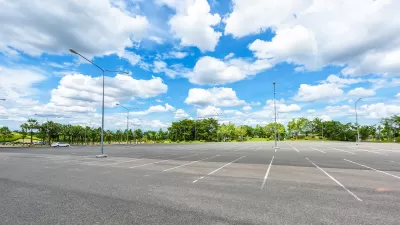In Washington state, onerous parking requirements are a major factor in a growing childcare shortage.

Minimum parking requirements are having a new, unexpected negative impact: limiting access to childcare.
As Catie Gould explains in an article for Sightline, parking requirements across the Cascadia region of the Pacific Northwest are making it “difficult or impossible to permit new daycares if the sites are unable to meet that arbitrary asphalt standard,” worsening an existing childcare shortage.
In Clark County, for example, there are three or more children under five for each slot available at a licensed childcare provider. According to Gould, “Sixty-three percent of Washington families live in a childcare desert, the sixth worst in the United States. The lack of access was estimated to cost $6.9 billion to Washington’s economy in 2023.”
Between state requirements of at least 75 square feet of outdoor play space per child and an average of 87 square feet of parking per child, Sightline estimates that a childcare center wanting to serve 50 children would need 8,100 square feet of outdoor space. “There simply aren’t many land parcels in Washington cities that have that surplus of space.”
According to Gould, cities that have reformed their parking regulations have seen a rise in new daycare openings. “Removing parking mandates won’t remove every obstacle to new childcare services, but it’s a no-cost solution that can make an immediate difference for families across Cascadia.”
FULL STORY: Parking Mandates Are Keeping Kids Out of Daycare

Study: Maui’s Plan to Convert Vacation Rentals to Long-Term Housing Could Cause Nearly $1 Billion Economic Loss
The plan would reduce visitor accommodation by 25,% resulting in 1,900 jobs lost.

North Texas Transit Leaders Tout Benefits of TOD for Growing Region
At a summit focused on transit-oriented development, policymakers discussed how North Texas’ expanded light rail system can serve as a tool for economic growth.

Why Should We Subsidize Public Transportation?
Many public transit agencies face financial stress due to rising costs, declining fare revenue, and declining subsidies. Transit advocates must provide a strong business case for increasing public transit funding.

How to Make US Trains Faster
Changes to boarding platforms and a switch to electric trains could improve U.S. passenger rail service without the added cost of high-speed rail.

Columbia’s Revitalized ‘Loop’ Is a Hub for Local Entrepreneurs
A focus on small businesses is helping a commercial corridor in Columbia, Missouri thrive.

Invasive Insect Threatens Minnesota’s Ash Forests
The Emerald Ash Borer is a rapidly spreading invasive pest threatening Minnesota’s ash trees, and homeowners are encouraged to plant diverse replacement species, avoid moving ash firewood, and monitor for signs of infestation.
Urban Design for Planners 1: Software Tools
This six-course series explores essential urban design concepts using open source software and equips planners with the tools they need to participate fully in the urban design process.
Planning for Universal Design
Learn the tools for implementing Universal Design in planning regulations.
Ascent Environmental
Borough of Carlisle
Institute for Housing and Urban Development Studies (IHS)
City of Grandview
Harvard GSD Executive Education
Toledo-Lucas County Plan Commissions
Salt Lake City
NYU Wagner Graduate School of Public Service





























